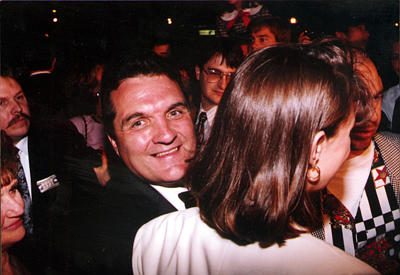
Rudy's "Never Give Up" Philosophy
On October 14, 1993, after the movie premiered, Connie Chung interviewed Rudy on her television program. Rudy's tenacious "Never Give Up" philosophy was expressed so well in his honest and forthright responses to her questions that it bears repeating.
Rudy told her when he first asked the screenwriter to consider the movie he told him, "Frankly, I hate Notre Dame." Rudy made an appointment with him to talk about the movie. He flew to California and waited for him at a restaurant they agreed upon for lunch. Rudy said he stood him up for lunch. He was two hours late, so he went to his home, knocked on the door, and said: "You're late for lunch." The screenwriter said he forgot it.
Connie commented on a remark made by the screenwriter about Rudy: "Rudy is like a crab, once he latches on, he doesn't let go." She asked Rudy if he was -- "a pain in the butt" and Rudy said, "Yup, he was." He said he believed you should never give up on your dream. That if you stay true to your dream, if you work hard enough, and don't give up, it just may come true."
Later the screenwriter, Pizzo, described the Rudy movie as "a story of courage."
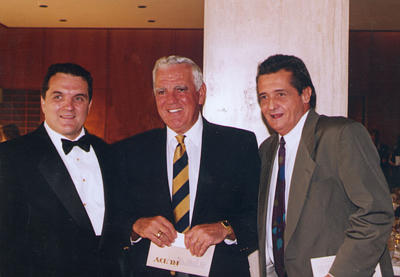
It occurred to me that information I had about Fr. John J. Cavanaugh might be useful to the plot of the movie. I sent it in writing to Rudy and the screenwriter but I had no way of knowing if it ever reached them. More than a year went by after the movie was premiered in South Bend, before I made an attempt to contact Rudy to verify the Grotto facts in the Rudy movie and let him know I had a story about Father Cavanaugh that might be very meaningful to him.
I made an impromptu telephone call and was pleased to hear Rudy's voice on the other end of the line. He graciously offered to fill me in on the details I was interested in. He verified the night of prayers he spent at the Grotto and said: "The Grotto gave me that real resolution of who I was and what I had to do." He said, he believed the movie represented the "Spirit of Notre Dame."
The segment in the movie about the night he spent at the Grotto was accurate, he explained, but Father Cavanaugh's character was a composite of two people who listened to him and helped him. He verified that he did not meet Father Cavanaugh on the steps of the administration building as the film showed. Instead it was on the steps of Corby Hall (the residence for priests on campus) which is adjacent to the Grotto lawn. These two items were of particular significance when tied with Rudy's frequent Grotto prayers. What I had learned, in having known Father Cavanaugh, I now knew would be of particular interest to Rudy:
Early in my conversational friendship with Father Cavanaugh he told me how he happened to come to the University. It paralleled Rudy's own efforts to get into Notre Dame. The memory of early conversations with Fr. Cavanaugh -- this being another of his stories -- came back to me, urging me -- as I had done with the missing crown story and the Vengeance Tree -- to follow this crazy notion I had that I was on to something I had to pursue. In this case, something that might be of interest, especially to Rudy, whether or not it was material the writer could use for the movie. I awoke the next morning with the same notion spinning around in my brain. It sparked an inner urging I couldn't deny.
It came to me that Father Cavanaugh might be a key factor, the spark or hook that Rudy's whole dream (football at Notre Dame, and the film) hinged on. I knew Fr. Cavanaugh had a gift for "passing it on" and that he lived by that premise. This was the story Fr. Cavanaugh told me about his own life.
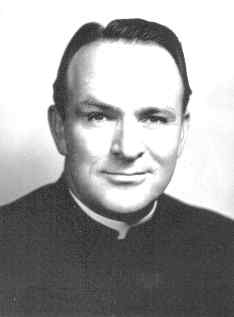
He said his father died when he was very young and he had to leave school to help support the family. One of four children, he worked from the ages of 14-18, for a man in the coal business but he had taken some business courses. His younger brother Frank entered the Notre Dame seminary at age 14. While visiting his brother Frank at the University he met, by chance, the then president of Notre Dame, Fr. John W. Cavanaugh on the porch of the Corby Hall rectory (the same place Rudy met him more than a half a century later).
In 1917, two years after his brief encounter with Fr. John W. Cavanaugh on the Corby hall porch, John J. Cavanaugh said he decided he wanted to go to college. He said he got the idea of writing to Fr. J. W. Cavanaugh (they were not related) to express his hunger for an education and ask him if there was any way he could get into Notre Dame without a high school diploma. He said he hoped it might come to Fr. Cavanaugh's personal attention and because they shared the same name it might spark his interest.
He said, Father J. W. Cavanaugh wrote to him and invited him to come and see him saying, "Wouldn't it not be fine if you and I were running the university together?" Father John J. told me that it was agreed that he would become the president's secretary for two years and after that he would be free to pursue any course of study he might choose.
Two years later, in 1919, he entered Notre Dame. The summer before his senior year he told me he was secretary to the secretary to Ford at Ford Motors. Before graduation through the first Fr. Cavanaugh he met Erskine who invited him to come to Studebaker Corp. in the advertising department. He worked there from 1923-1925. At the time, he told me he was engaged to a young lady but more and more he felt the call to become a priest and in late 1925 he entered the novitiate. At the same time, his intended became a nun. He told me they remained good friends the rest of their lives though they were widely separated by the distances of their respective callings. Of course, the rest is history, Father John J. Cavanaugh, himself, in 1946, became the fourteenth President of the University and his former intended also rose in the ranks of the Sisters of the Holy Cross.
Being the kind of man he was he passed on the favor done for him whenever he could. He told me how he recognized Fr. Ted Hesburgh's special talents early on and began grooming him to become the next president. And later more than a half century after his own good fortune in getting into Notre Dame, I am sure, he must have recognized himself in Rudy when he met him for the first time on the same spot he met his benefactor, Fr. John W. Cavanaugh who had extended an understanding heart and a helping hand to him. In a like way, his warmheartedness and understanding became my inspiration several years later.
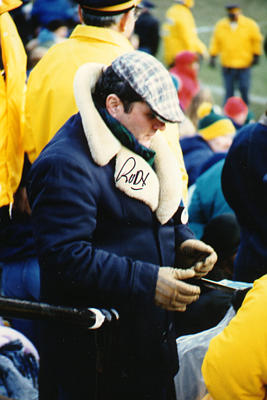
In making the movie, without knowing it, Rudy was singing his own and Father Cavanaugh's song -- he was passing the encouragement on: "Follow your dreams, if I can do it, you can do it." Just as we all should follow our dreams in our own individual way. It's what life is all about. A chance for the individual to fulfill his potential; to make a difference; to leave his "footprints on the sands of time."
Undoubtedly Fr. Cavanaugh exceeded his own expectations in becoming not only a priest but also a president of Notre Dame -- as did Fr. Hesburgh who followed in his footsteps and received worldwide honors in his own lifetime. All exemplify the "Spirit of Notre Dame" and all it stands for. Rudy may have played only 27 seconds of a football game but in putting his story and his love of Notre Dame on film he was also "winning one for the Gipper" in the Notre Dame tradition.
I'm convinced we are all given different dreams for a reason, as we're given different personalities and talents to accomplish them. Fr. Sorin, himself, was a vibrant and passionate example of how good fortune follows the fearless and the faithful. And it can happen to anyone, like Rudy, who has the tenacity to follow their dreams. No matter where life sends them, no matter how long it takes. Who "go out on a limb because that's where the fruit is".
Whether or not we consciously put God in the picture, I believe faith and believing is what it's all about. How do any of us know when we may be that someone sent to get something done, unless we follow through. And so I am passing this information on to you, the reader, just in case it may inspire you to be a link in the chain of events that makes the world a better place to be.
Rudy explained the composite characters of Father John J. in the film version, he also told me that actually Father Cavanaugh was not the one who gave him 10,000 reasons not to go to Notre Dame as the movie portrayed it. That he simply listened to him and made arrangements for him to see the Provost the next day. "Ah," I told him, then he must have been the key that opened the door wasn't he?" To which, Rudy readily agreed. All of which convinces me that, unknowingly, in not finding Father Hesburgh that night, and running into former President Fr. John J. Cavanaugh, instead, he had found the perfect person to be in sympathy with his own hunger to be a part of Notre Dame.
Having known Father Cavanaugh, there is no doubt in my mind that he would have done just that. Like the first Father Cavanaugh did for him, he may have opened the door by being his introduction to the Provost, but it was up to Rudy to take it from there. In that, they shared much in common. With prayer, gumption and never giving up, they both achieved their goals in most extraordinary ways. Blessings are still flowing for Rudy since the movie. He now has a lovely wife, Cheryl, and they have a little daughter named Jessica Noel. What better place to leave those numberless prayers than with Our Lady at the Notre Dame Grotto. She is the ultimate symbol of unshakable faith.
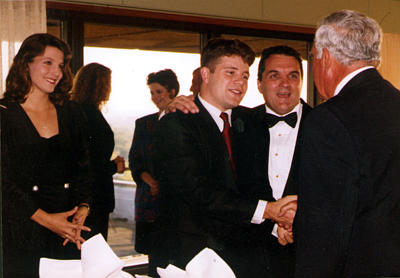
Visit to the Grotto gives courage to face problems
Five months after the fire at the Grotto, on February 14, 1986, Pete Pranica, senior American Studies major, wrote an article about the Grotto which appeared in The Observer. It was entitled: "Visit to Grotto gives courage to face problems." I'm sure Rudy would agree, his words -- in remembrance of the Grotto -- apply to his own Notre Dame experience and are words of encouragment all students should take with them on graduation day.
There's one place in all the world I wouldn't trade. The Grotto. In a world which is changing faster than you can say 'digital,' it's nice to know that there's one place which never changes. The Grotto.
We all have legitimate reasons for self-doubt and depression. There are times when it seems the sun doesn't shine for a week. We're all human and we're allowed the privilege of being in a blue funk every now and then. The question is not how deep the funk is, it's how you come back from it.
George Steinbrenner has a saying in his office. It says: 'I am wounded, but not dead, I will lie here and bleed awhile, but I will rise to fight again.' That pretty much says it.
In its own way, the Grotto has seen more bloodshed than any battlefield. Even in the darkest night, in the small hours of the morning, the Grotto is a receptive place, full of compassion beyond even human touch.
Churches are beautiful works of the designers art, but even the most eloquent architectural statement is no match for the simple outdoor quiet of the Grotto. While churches are ornate, the Grotto is a simple space for the simple yet incredibly complex process of human retrospection. There is no other place quite like it.
When the world is seemingly crushing you into the ground, set aside a few minutes and go to the Grotto in the morning or evening. You don't have to pray; just sit if you like. Just let it be. Instead of trying to be in control, let go.
Let the quiet peacefulness which denies mere words wash over you. Visiting the Grotto will not make problems disappear, but I'm willing to bet that the peace and quiet will give you the peace of mind to get at those problems.
Generations of Notre Dame students have paused in that quiet cove to bleed awhile, only to rise and fight again. That is why we are Notre Dame.
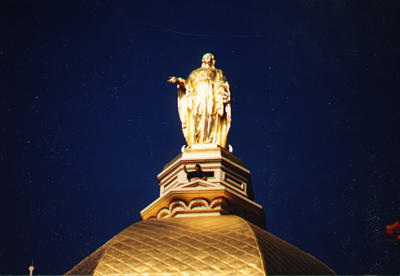
Most Notre Dame graduates remember the Grotto with a special reverence and few fail to visit it upon their post-graduate visits to the campus. The Grotto epitomizes everything Notre Dame represents.
Like hands folded in prayer, the flames on the candles at the Grotto symbolize the special part it plays in the lives of so many students.
Henri Lasserre's theory of grace expressed in his "Dear Reader" letter could also have been written about my second illustration. I believe it is evidenced in the chance way I stumbled upon the information I was seeking about Dooley's letter and the black box with the Plexiglas lid that enclosed it. I not only learned who engineered its placement at the Grotto and how it was done but I also received the answer to a question about the Grotto I'd given up on two years earlier. Subsequently, this re-search also led to additional Grotto experiences which would not have been shared without it.
In brief, Lasserre put it this way:
Sometimes our radiant protector acts directly, giving us sudden inspirations, happy thoughts, urging us to write a letter, to say such or such a word, to take such or such a step, indifferent perhaps in themselves, but which as he well knows, are to be the first links in a chain of secondary causes which will effect our future lives.
Lasserre ended his "Dear Reader" letter with this gentle reminder: "To recall such truths, little known, perhaps, or forgotten, is not an idle digression. It is a torch to enlighten us on our way!
I would like to recall for my readers, this second illustration of "the links in a chain of secondary causes" which can effect the future lives of ourselves and others which I experienced while researching Dooley's letter and its placement at the Grotto.